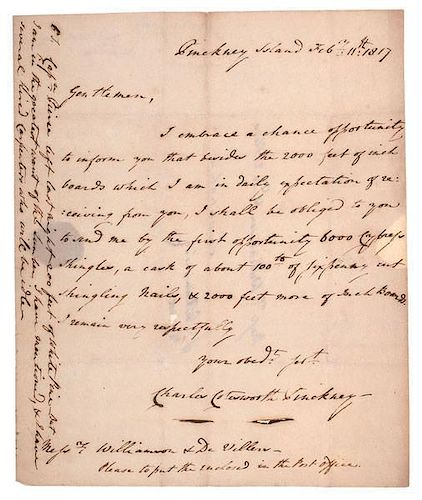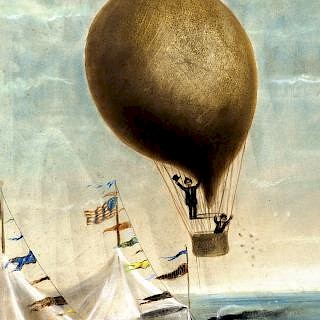Charles C. Pinckney, Signer of the US Constitution, ALS, February, 1817
About Seller
6270 Este Ave.
Cincinnati , OH 45232
United States
With offices in Cincinnati, Cleveland and Denver, Cowan’s holds over 40 auctions each year, with annual sales exceeding $16M. We reach buyers around the globe, and take pride in our reputation for integrity, customer service and great results. A full-service house, Cowan’s Auctions specializes in Am...Read more
Two ways to bid:
- Leave a max absentee bid and the platform will bid on your behalf up to your maximum bid during the live auction.
- Bid live during the auction and your bids will be submitted real-time to the auctioneer.
Bid Increments
| Price | Bid Increment |
|---|---|
| $0 | $25 |
| $500 | $50 |
| $1,000 | $100 |
| $2,000 | $250 |
| $5,000 | $500 |
| $10,000 | $1,000 |
| $20,000 | $2,500 |
| $50,000 | $5,000 |
| $100,000 | $10,000 |
About Auction
Jun 13, 2014 - Jun 14, 2014
Cowan's Auctions dawnie@cowans.com
- Lot Description
1p ALS, 7.75 x 9.5 in. Pinckney Island, 11 Feb. 1817. Charles Coatsworth Pinckney to Messrs. Williamson and De Villers, Savannah. Order for lumber, shingling nails and cypress shingles for construction of his home on the island. A note along the side indicates: "I have several hired carpenters who will be idle."
Charles Coatsworth Pinckney was born to a well-off planting family in South Carolina in 1746. His brother, Thomas, was Governor of the state among other political offices, as were other close family members. In 1753 the Pinckneys went to London where his father, Charles, was an agent protecting South Carolina's interests. The boys studied in English schools, and after the family returned to the colony, Charles C. remained in Europe studying at Oxford and in France.
After he returned to North America, he married Sarah Middleton, whose father, Henry, was the second President of the Continental Congress, and whose brother was a signer of the Declaration of Independence. Sarah died in 1784, and Pinckney remarried a couple years later.
He practiced law in Charleston, and served in the colonial legislature on his return. When the Revolutionary War broke out, Pinckney volunteered for service in the Continental Army. He saw action first in the defense of Charleston, then moved north to join Washington near Philadelphia. It was about this time he met other future founders, such as Hamilton and James McHenry.
After the war Pinckney returned to politics, and represented South Carolina in the Constitutional Convention. He advocated a strong national government with checks and balances, and thought the Senate should be composed of men of wealth who need not receive pay for their service, much like the House of Lords in London. After the Constitution was adopted by the convention, Pinckney worked to secure ratification in South Carolina. He participated in framing the State constitution, then retired from politics.
However, Washington offered him a cabinet post, which he declined, but he accepted the ambassadorship to France. In 1800 he became the candidate for Vice President with John Adams running for a second presidential term, and the party nominated him as its presidential candidate in 1804 and 1808. Jefferson was the victor in the first two elections, of course, and Madison in the third. He did serve as president-general of the Society of the Cincinnati.
As a footnote, Pinckney Island is now a National Wildlife Refuge. After its plantation days, it was maintained as a private wildlife refuge before being transferred to the national system.Light overall toning. Some soil along folds on verso, and a slightly darker area upper right on recto.Condition
- Shipping Info
-
SHIPPING. At the request of the buyer, Cowan's will authorize the shipment of purchased items. Shipments usually occur within two weeks after payment has been received. Shipment is generally made via UPS Ground service. Unless buyer gives special instructions, the shipping method shall be at the sole discretion of Cowan's Auctions, Inc.. Cowan's is in no way responsible for the acts or omissions of independent handlers, packers or shippers of purchased items or for any loss, damage or delay from the packing or shipping of any property.
-
- Buyer's Premium



 EUR
EUR CAD
CAD AUD
AUD GBP
GBP MXN
MXN HKD
HKD CNY
CNY MYR
MYR SEK
SEK SGD
SGD CHF
CHF THB
THB




